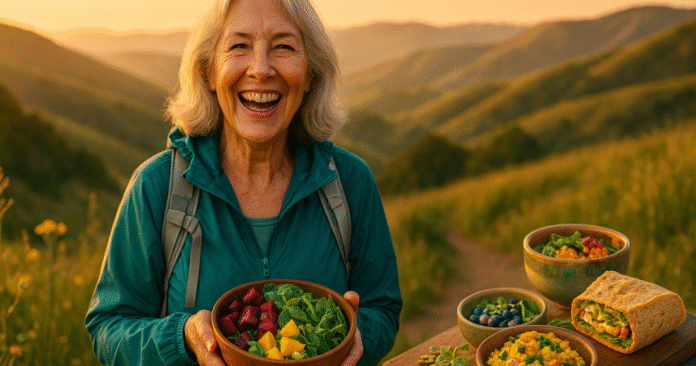When my hiking buddy Joan, a 73-year-old former school-teacher who still beats me on the uphill sections, told me, “These vegan habits make me feel more energized in my 70s than I did in my 20s,” I couldn’t help peppering her with questions.
What exactly was she doing differently?
And could someone in their forties (hi, that’s me) borrow the same playbook before the warranty on our joints expires?
Below is the distilled, lived-in wisdom Joan shared, plus the tweaks I’ve tested on myself over the last year.
Think of it as a plant-powered field guide for anyone who wants to feel lighter on their feet — no matter when they were born.
1. Starting the day hydrated
Joan swears by a tall mason jar of warm water, a squeeze of lemon, and a few drops of B₁₂ the moment her eyes open.
Why it works: after a seven-hour fast, your cells are parched, and even mild dehydration can sap your mood and attention. The lemon adds potassium; the B₁₂ bridges the one micronutrient most vegans miss.
I copied her ritual on a writing deadline recently and noticed my usual mid-morning slump simply… didn’t arrive. Coincidence? Maybe—but my refillable bottle now lives on the nightstand.
Question for you: What’s the first thing your body gets every morning—caffeine or plain old H₂O?
2. Choosing whole foods over vegan junk
“The longer your food lasts on a shelf, the shorter you last,” observes longevity researcher Dr. David Sinclair, whose own diet is predominantly plant-based.
Joan’s cart is a case study: steel-cut oats, berries, lentils, sweet potatoes, greens. Compare that to my old stash of frozen “chick’n” nuggets and oat-milk ice cream and it’s obvious why she outruns me.
Processed vegan snacks are fine as occasional pleasure, but their refined oils and sodium won’t power you up Kilimanjaro.
Next grocery trip, spend 80% of your budget in the produce and bulk aisles and watch your afternoon energy even out.
3. Building a rainbow on every plate
If Instagram taught us anything, it’s that vibrant bowls get the likes. More importantly, pigments equal phytochemicals — nature’s tiny repair crews.
Joan batches trays of turmeric-roasted cauliflower, beet hummus, and purple-cabbage slaw every Sunday.
She calls it “insurance cooking.”
Not into prep marathons?
Try the one-color-per-meal challenge for a week: breakfast in shades of orange (papaya, carrots), lunch in greens, dinner in reds. Your mitochondria will throw a party.
4. Diversifying plant proteins
Old-school vegans lived on peanut butter and wishes; modern eaters have tempeh, hemp seeds, and black-bean pasta.
Travel once taught me this trick.
In Kyoto, monks combine brown rice with sesame seeds; in Addis Ababa, families scoop injera with lentils.
Different cultures, same biology lesson: mix your legumes, grains, nuts, and seeds, and you’ll hit the full amino-acid set without a calculator.
I’ve mentioned this before, but it bears repeating — rotate your staples and you’ll dodge boredom and nutritional potholes at the same time.
5. Practising time-smart eating
Joan naturally slides her meals between 9 a.m. and 7 p.m. She’s not militant about it; she just dislikes late-night dishes in the sink.
Science backs her intuition.
A steady 12- to 14-hour overnight fast gives your digestive system room to repair and keeps blood sugar smoother the next day.
I started closing the kitchen at 8 p.m., and my smartwatch claims I’ve shaved five points off my resting heart rate.
Anecdotal, sure — but the numbers make me a believer.
6. Moving before (and because of) meals
Here’s one of Joan’s quirks I love: she munches a banana, walks the neighborhood loop, then settles down for breakfast. The light activity primes muscle cells to soak up the incoming glucose instead of letting it loiter in the bloodstream.
I tested the same loop after lunch and noticed the post-meal fog lift. Add a podcast and you’ve doubled the payoff.
What short burst of movement can you tack onto your meal routine starting today?
7. Sharing food with a tribe
Remember those dorm dinners that stretched until midnight?
Joan recreates that vibe with a monthly potluck: invite list capped at eight, theme rotates (Southern soul-food gone vegan was a hit), phones in a bowl by the door.
Community isn’t fluff—harvard’s famous longevity study pins social connection as a top predictor of healthy aging. Meals are the easiest glue we have.
My contribution last month—cashew-kimchi tacos—sparked so much recipe swapping I barely noticed we’d hit 10 p.m. with energy to spare.
The bottom line
When Joan and I swap stories on a ridgeline, I’m reminded that vitality is less a genetic lottery and more a quiet vote we cast with each meal, sip, and step.
Her seven plant-powered habits aren’t magic tricks — they’re small, repeatable gestures of respect for a body that still wants to wander and wonder.
The older I get, the clearer it feels: energy is the compound interest of daily choices, and the dividend shows up in places metrics can’t measure — unplanned detours, deeper laughs, an appetite for the next hill.
So try one habit, then another, and pay attention to how the world feels when your cells hum instead of groan. Future-you might look back and realize that choosing plants was really choosing possibility.






